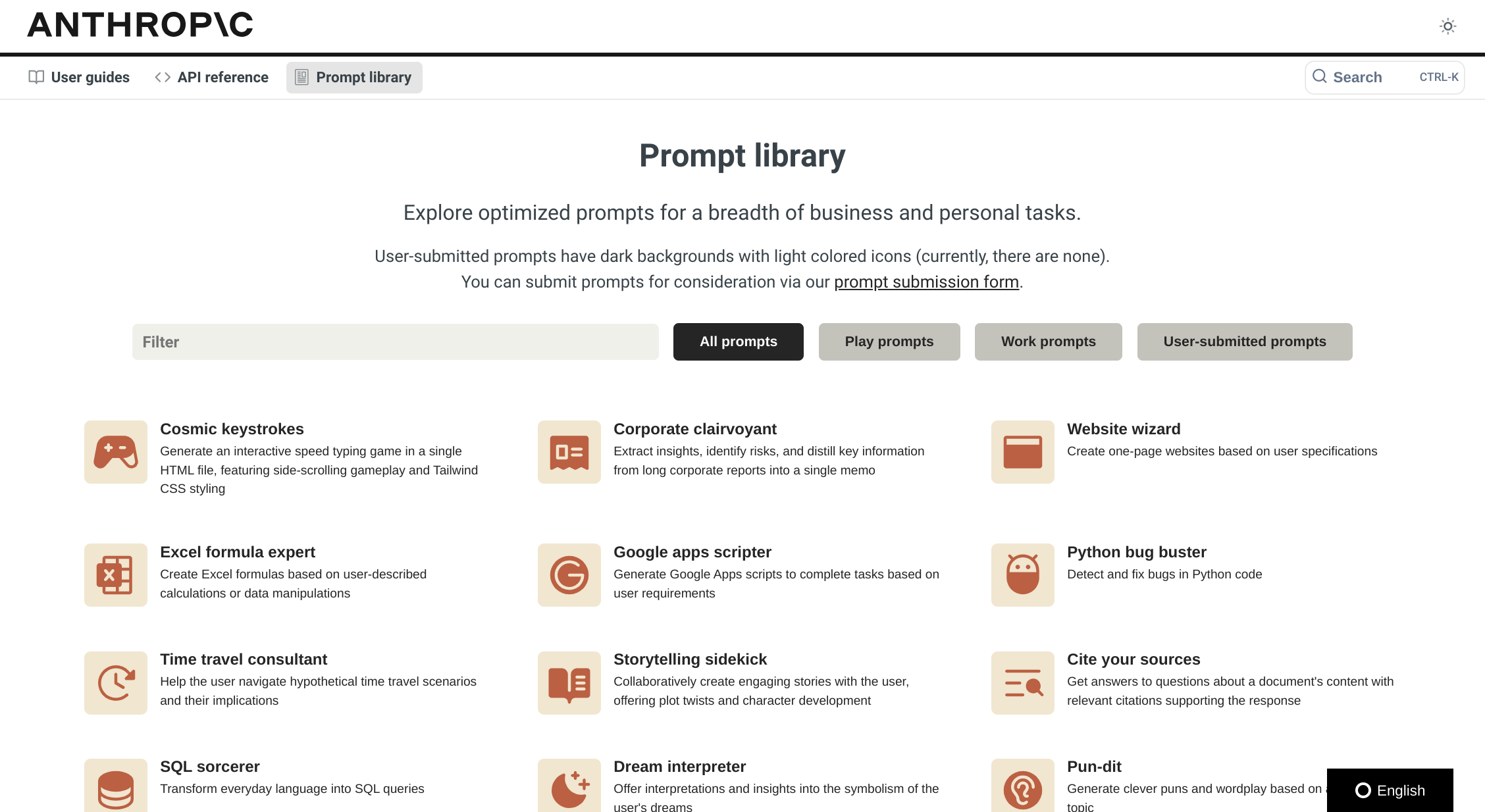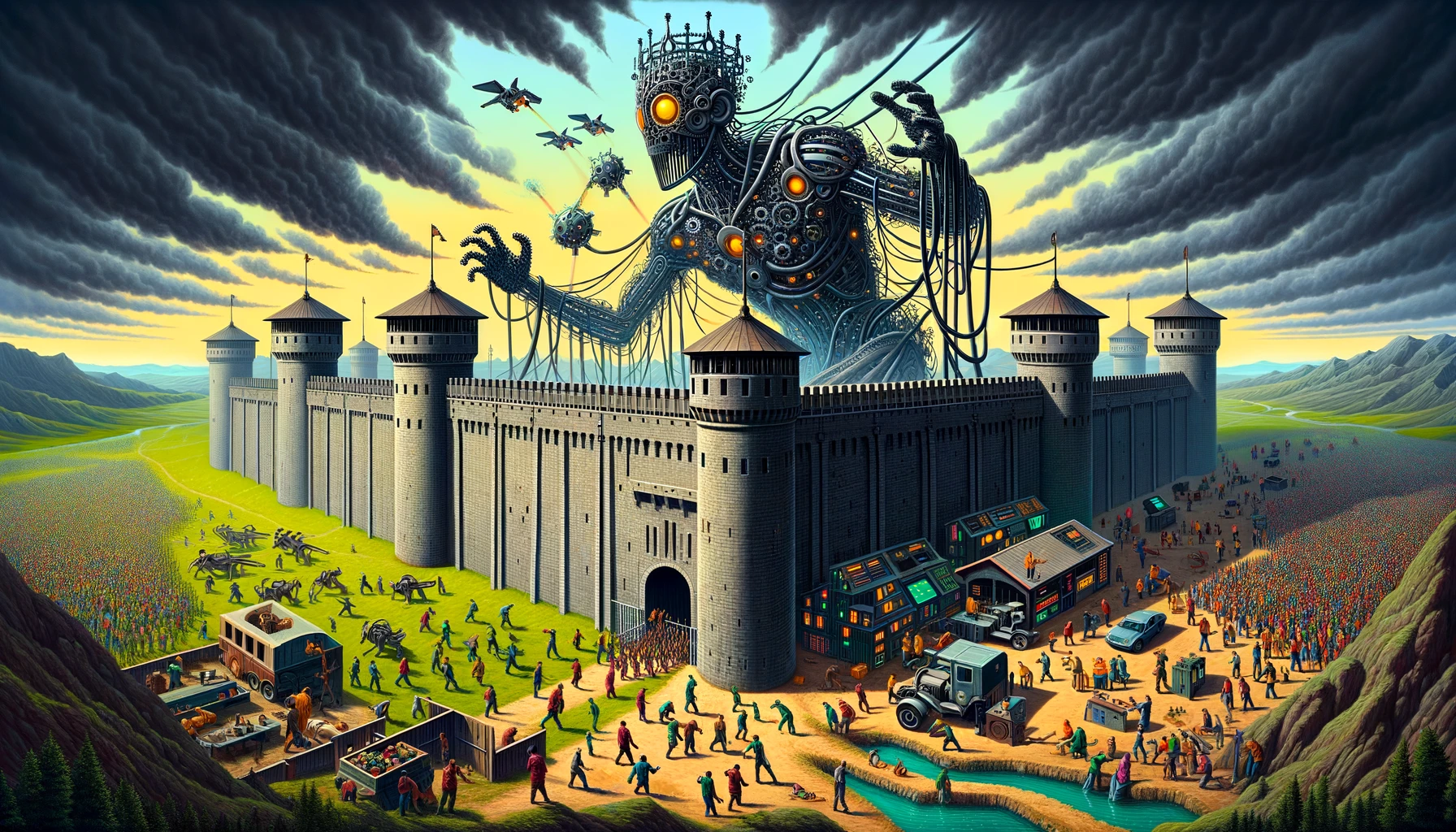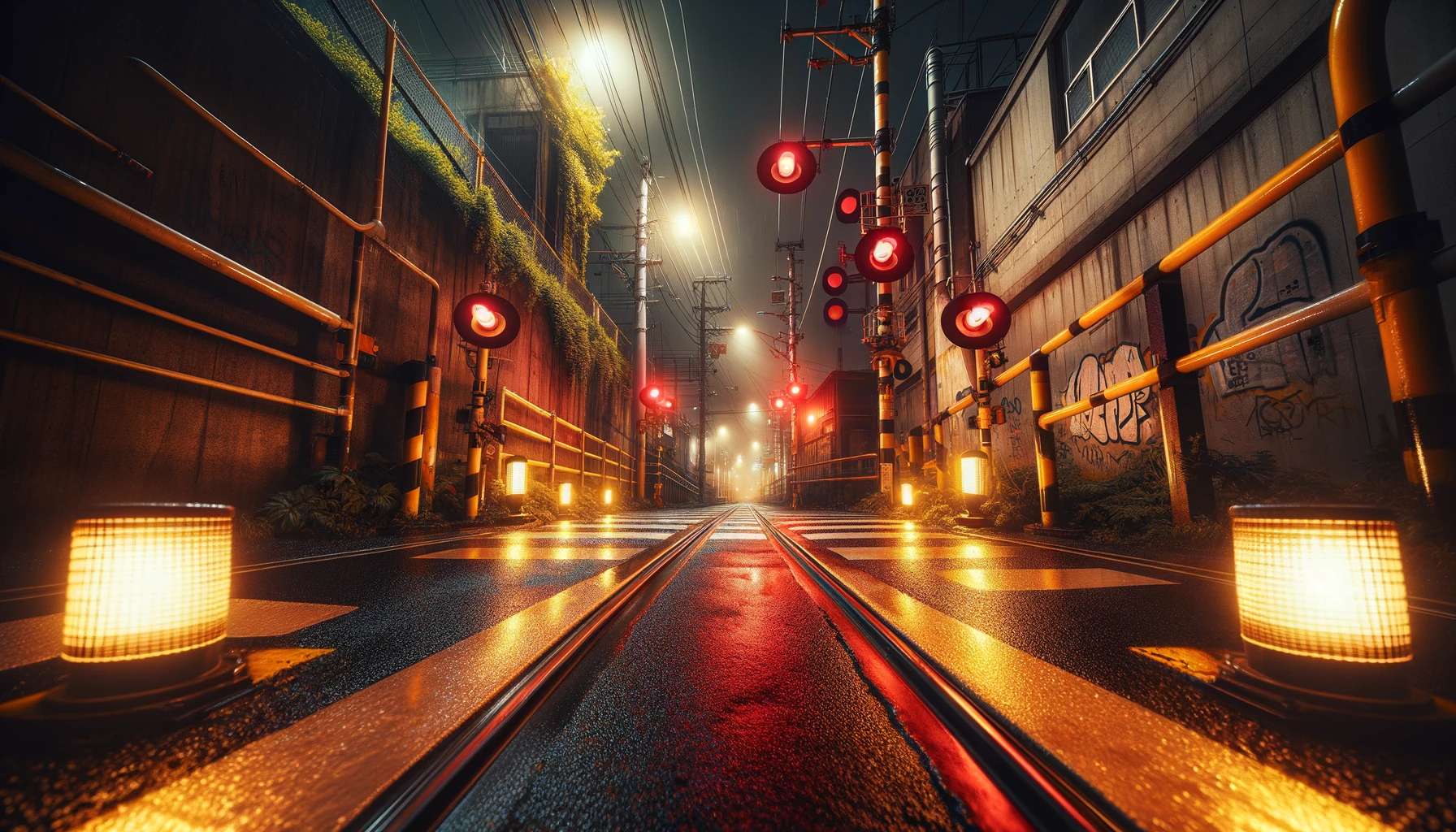New posts from thoughtshrapnel.com
Thought Shrapnel
Claude's Prompt Library

Anthropic, the organisation set up by ex-OpenAI staffers, has recently released Claude 3. This is apparently even more powerful than GPT-4, although I haven’t had a chance to play with it yet.
Alongside the release, Anthropic has also shared a Prompt Library which, I guess, is the equivalent of OpenAI’s GPTs.
Source: Anthropic Prompt Library
Absence is not a (defect)ion
<img src=“https://cdn.uploads.micro.blog/139275/2024/1922dd0f-2054-4f52-b82f-d17c513dfe80.webp” width=“600” height=“342” alt=“This image is a digital collage that layers photographic textures with digital painting. A monochrome urban landscape in dark gray symbolizes the conventional work environment, while vibrant pockets of red, yellow, and blue form miniature worlds floating above the city. These bubbles represent “temporary autonomous zones” where individuals can engage in purposeless action and creativity, highlighting the contrast between the daily grind and the personal sanctuaries we create for ourselves.”>
I hadn’t thought of the early days of the pandemic as being akin to a general labour strike. Interesting. I could quote the entirety of this article, but I’ll just mention one thing that I haven’t included below: “It is because of its emptiness that the room is useful.” (Lao Tzu). The author of this article, David J Siegel, uses this to make the point that I’ve used as the title for this post; that absence is not defection.
The early period of the pandemic (which approximated in many respects a kind of general labour strike) gave some of us an intimation of what life lived largely off the clock can be like when much of what passes for work is suspended or slowed and we are afforded precious ‘little gaps of solitude and silence’, as the French philosopher Gilles Deleuze called them, to engage in worthy pursuits that elude us under normal circumstances. We found incomparable personal freedoms and new opportunities for enrichment and fulfilment in the cessation of many of our standard operating procedures.
Then, as everyone recalls, we were summoned back to the office. But, once we had experienced this new way of being, the prospect of returning to the old order – submitting to the control, policing and surveillance of our former workaday lives – became almost unthinkable, especially for members of a chronically insecure workforce forced to endure low pay, lack of opportunity for advancement, inflexible schedules, and a multitude of everyday insults and indignities. Perhaps the chief insult to us all is the governing assumption that we must be collocated – or collated – to do our best work, despite having demonstrated our capacity for self-directed productivity from home (or other private quarters) under the most trying circumstances.
[…]
In The Scent of Time: A Philosophical Essay on the Art of Lingering (2009), Byung-Chul Han suggests that our experience of intervals is being ‘destroyed in order to produce total proximity and simultaneity’. When everything (and everyone) is within reach at all times, we lose a sense of what it means to be in – and even to savour – transitional states of in-betweenness. As an antidote, [some authors] recommend that we ‘tarry with time’ and ‘make spaces for the play of purposeless action’.
We can, in other words, reappropriate some of the time and space being withdrawn from us. These can be reclaimed in the fugitive moments we thieve from the calendar, or they can be recovered in what the anarchist Hakim Bey in 1985 called ‘temporary autonomous zones’: undetectable underground enclaves that we carve out of the landscape of our everyday lives in order to find or free ourselves. Simultaneously, practices of disengagement might withdraw from organisations (workplaces primary among them) their extraordinary power to mediate – to dictate and direct – far too many aspects of our existence and experience. Opting to bypass certain workplace amenities and conveniences expertly designed to keep us at work – the cafeteria, the fitness centre, the dry cleaner, the onsite health clinic – might not seem like much of a tactic of rebellion, but it does its part to lessen our dependence on our employer as lifehack, helpmate or healer.
[…]
Withdrawal has an almost universally negative connotation in public life, where it is treated as the ultimate transgression and disdained as retreat or defeat – the very opposite of engagement. However, to withdraw is also, crucially, to repair – both to go to a place and to mend. From this perspective, withdrawal is not merely a defeatist tack; rather, it is, or can be, direct action for a restoration of intellectual life – the kind that is free to ask (to fully engage with) impertinent questions – in settings that have practically banished it, made it inaccessible, or are attempting to monitor and monetise it according to terms not of our choosing.
[…]
Among the questions some of us are investigating in our contemplative moments of disengagement, withdrawal, removal, retreat or escape – however we choose to designate those instances when we take our leave – are these: when, or to what extent, do our norms of organisational affiliation and attachment make us sick or otherwise compound the very problems such forms of connection are meant to solve? In what ways might our occasional absences improve our solitary and even our solidary experiences of work and of life more generally?
Source: Aeon
Career vs Job

This post by Tim Klapdor is definitely related the Aeon article I quoted about carving out time for reflection.
People are surprised when I say that I do about 20-25 hours of paid work per week. Somehow that’s ‘part time’. But I live a full life: studying, writing, taking my kids here, there, and everywhere. The only thing missing? I’d like to travel more, professionally.
A career contains a multitude of jobs. Some of them are the ones you get paid for, but many of them aren’t. And that’s often where the confusion comes into play. The paid job begins to bleed into other areas, and you associate the paid job with all the other jobs. They get lumped together as a career, but they are distinct and need to be kept separate. It’s our mind that blends them together, so every so often, we need to pull focus, reevaluate and paint in the edges to make it clear what our jobs really are.
[…]
In reflection, I can say that for the last few years, I’ve paid too much attention to my paid job and not my career. I’ve allowed the job to expand beyond its parameters and edges to consume everything around it—my time, attention, and priorities. What I need to do, and what I plan to do in 2024, is to switch that.
I want to focus on my career, not my job.
Source: Tim Klapdor
Scintillating scotomas

It’s weird to think that I was about my son’s age (17) when I started getting migraines. It wasn’t a massive surprise: there were migraineurs on both sides of my family, including my mother and my paternal grandmother. I may have literally dodged a bullet: being susceptible to migraines disqualifies you from pretty much every role in the Royal Air Force, to which I was in the process of applying.
These days, partly through stress management, ensuring I get good sleep, avoiding dehyrdration, and taking some supplements I’ve found helpful, my migraines are both less frequent and less extreme. They’re still part of who am, though, and I know to get off screens immediately and take some of my meds if my vision starts getting distorted.
How to describe a scintillating scotoma? It’s one of the most common symptoms of a migraine, but unless you’ve had one, it sounds unreal. A scintillating scotoma is like a barbed ripple in the pool of sight. It’s a skeletal Magic Eye raised up from the flatness of the world. It’s a glare on the tarmac as you drive West at sunset on a rain-slick freeway—only when you turn your head, it’s still there, so you have to pull over, close your eyes, and wait out the slow-motion firework working its way across your brain.
[…]
In the absence of an organizing mind, everything comes unglued. Faces go missing and dark holes seem to eat half the universe. Migraine sufferers can experience the uncanny sense of consciousness doubling known as déja-vu, or its cousin, jamais-vu, in which the world feels newly-made. The world might feel suddenly very unreal, fracture into a mosaic, or slow to a stop-motion pace, dropping frames. The self might cleave in two in a fit of somatopsychic duality. Writing about these bizarre and horrifying perceptual phenomena, the late Oliver Sacks observed that migraines “show us how the brain-mind constructs ‘space’ and ‘time,’ by demonstrating what happens when space and time are broken, or unmade.”
[…]
According to Migraine Art: The Migraine Experience From Within, migraine auras are as old as humankind—so old, perhaps, that they may have inspired the geometric forms of Stone Age cave drawings. Which makes recent attempts to generate migraine auras using convolutional neural networks seem particularly poignant to me: what began in stone, animated by the hot flicker of firelight, continues 5,000 years later, deep in the heart of servers whose mineral components were mined from the same dark Earth.
Source: Wild Information
Image: Manuscript illumination by Hildegard of Bingen, 1511 (who was a migraineur)
Be careful what you wish for
I’ve already posted a thread about this on the Fediverse, so I’ll just copy-and-paste then tweak from that rant. TL;DR: Adobe have published a (commissioned) report about digital credentials, everyone’s over-excited, and I want to sound a note of caution.

About 15 years ago, it was clear that Higher Education was about to become significantly ‘unbundled’ in western countries. The trend had started even before the start of my career, but accelerated around that time. We had things like Pearson being given degree-awarding powers, Massive Open Online Courses (MOOCs) allowing anyone to join university-provided courses, and the first blushes of digital credentials.
As thinkers such as Audrey Watters pointed out, unbundling is all well and good, but you better be damned careful about who’s doing the ‘rebundling’ and for what purpose. So, of course, the MOOC providers turned into non-profit and for-profit providers that met with various success (edX, Udacity, FutureLearn, etc.) These all needed ways to ‘certify’ their courses. Some partnered with universities, others went alone with their own credentialing.
The digital credentials space has always been a difficult one to keep track of. That’s because it’s decentralised by design, just like the Fediverse, and… email. So while there are absolutely standards that make the whole thing work (Open Badges, etc.) it’s always been difficult to talk about numbers and how people are using digital credentials. In true “the future is here, it’s just unevenly distributed” style, some sectors have seen explosive adoption of digital credentials.
IBM, for example, have issued millions of digital credentials for things that you wouldn’t necessarily go to university to learn. It’s a big deal, and leads to decently-paying (and often high-paying) jobs. That’s great, and I point to this a lot. But it’s not like IBM did it out the goodness of their hearts. They’re looking to remove the degree requirement for their jobs, which of course has a long-term depressing effect on wages.
Coming back to Adobe, while it’s great that they’ve suddenly discovered digital credentials and have commissioned A Report To Tell Us How Great They Are, we’d be naive to think that this is a benevolent act. What they’re doing, it seems, is positioning the ‘Adobe Certified Professional’ digital credential as the one that you need in that particular industry. That means tying ‘creativity’ to using certain tools, and having a very privatised ‘rebundling’ of knowledge and skills.
So, be careful what you wish for, I guess. Could a lot of this have been foreseen over a decade ago? Absolutely. But the problem, as many on the Fediverse will recognise, is that there’s a vested interest in not recognising the diversity of human experience. Digital credentials could and should be used to recognise lifelong and lifewide learning. They can be used to showcase the breadth of our experience in a holistic way.
That’s not what brands are interested in, though. Brands are interested in capturing and enclosing you as data points to be packaged up and sold alongside their proprietary products.
I’m sure there are plenty of people in my network (especially on LinkedIn) which will see this as an over-reaction. “But Doug, isn’t bringing more attention to the space worthwhile?” Not if the lens that is used to understand the space is reductionist and perpetuates some of the very problems we’re trying to solve.
Gone are the days of a college degree being the only key to unlock meaningful careers. Employers today need job candidates and employees with new, in-demand skills, and they expect to see them demonstrated in a variety of ways beyond a college transcript. With the rise of remote work, digital transformation, and AI, today’s most in-demand skills — creative problem-solving, visual communication, and digital fluency — are especially hard for hiring managers to identify in job application materials.
To shed light on this evolving landscape, Adobe has just released a research white paper, “The Creative Edge: How Digital Credentials Unlock Emerging Skills in the Age of AI.” Conducted by Edelman, the results of this commissioned global research study outline the role digital credentials play in helping career seekers get hired by showcasing their digital and creative skills.
Source: How digital credentials unlock emerging skills in the age of AI
Image: DALL-E 3
Vendor lock-in writ large

People call me prolific, but I’m nothing compared to Cory Doctorow. I can’t keep up with his mostly-daily newsletters, never mind his longer-form stuff.
In this piece, he talks about one of his favourite topics: vendor lock-in. However, the genius lies in the way that he explains, in a way that sounds so obvious that it feels like scales falling from your eyes, why people blame immigrants for the lack of jobs. The real, historical reason for the decline in good jobs is because employers (with government help) smashed the unions.
Moving onto AI, he points out the “monstrous proposition” of AI companies who suggest that their clients train models based on workers, then fire the workers, replacing them with the AI products. The latter are nowhere near good enough to actually do the workers’ jobs, but all the AI companies need to do is sell the proposition.
That’s why there’s no jobs around at the moment: an illusion based on VC money. Remember how Uber was going to mean self-driving cars and the end of public transport? Remember how cryptocurrencies were going to mean the end of banks? Here we go again.
Bruce Schneier coined the term “feudal security” to describe Big Tech’s offer: “move into my fortress – lock yourself into my technology – and I will keep you safe from all the marauders roaming the land”
It’s a tried-and-true bullying tactic: convince your victim that only you can keep them safe so they surrender their agency to you, so the victim comes under your power and can’t escape your cruelty and exploitation. The focus on external threats is key: so long as the victim is more afraid of the dangers beyond the bully’s cage than they are of the bully, they can be lured deeper and deeper until the cage-door slams shut.
But here’s the thing about trusting a warlord when he tells you that the fortress’s walls are there to keep the bad guys out: those walls also keep you in. Sure, Apple will use its control over Ios to stop Facebook from spying on you, but when Apple spies on you, no one can help you, because Apple exercises total control over all Ios programs, including any that would stop Apple from nonconsensually harvesting your data and selling access to it:
Source: Pluralistic
Consciousness porn

Sometimes, I come across a post which comes from leftfield and is almost impossible to quote in a meaningful way. This one revolves around three things I’ve never even heard of, let alone experienced. The author puts them under the heading ‘consciousness porn’, with the three examples being quite diverse.
What I find so fascinating is that there are layers upon layers to this. For example, one of the commenters points out that the guy shooting the long videos of walks around Tokyo posted to his YouTube channel that he was depressed, wasn’t going to do any more after uploading the ones he’d already recorded, and didn’t know why anyone watched them in the first place.
It took me a while to comprehend why my son would watch other people play videogames. After a while I began to understand that there was an element of learning how to improve his own gameplay, but there was also an aesthetic to it. This consciousness porn seems to be almost pure aesthetic. I guess the next stage is endless versions of this created using AI.
Rambalac does everything he can to avoid intruding on the world he is observing, to be, like the character in Christopher Isherwood’s novel Goodbye to Berlin, “a camera with its shutter open, quite passive, recording, not thinking.” But occasionally we catch a glimpse of his reflection in a store window or elevator mirror – oh, he’s not Japanese! And in every frame we feel his presence – quiet, sweet, and a little sad, stopping to watch a black cat thread its way across a cluttered stoop, showing us the label of the green tea he’s bought from a vending machine, looking away politely from a fellow pedestrian, or standing still, on a rainy night, before the red gate that marks the entrance to a Shinto shrine, entranced.
[…]
I often listen to dub techno while watching Rambalac videos, which amplifies their chill, phenomenological trippiness, and makes me feel like I’m experiencing a mutant artform invented by William Gibson. An artform I call consciousness porn.
Source: Donkeyspace
Image: DALL-E 3
Born to run

I set myself the target of running 1,000km this year. Camille Herron just ran 900km in six days 🤯
When the FURTHER event started last Wednesday, Herron was already the holder of multiple world records from 50 to 250 miles. A small crowd gathered under four towers of stage lights and rows of orange and white tents. The 42-year-old was in shades, a water bottle stuffed in the crotch of her shorts. On day one, she chugged a Coke float and ran 133 miles. Day two, she downed tacos and added another 113 miles. On 8 March International Women’s Day, she broke the American 48-hour road record for women. More would follow.
Each time Herron broke a record, she held her arms out wide, her hands pointing to the sky as if to say, “isn’t this incredible?” The fact that she is openly awed by what she does has at times made her a target in the ultrarunning community. Her whimsical pre-race mantra of “letting the magic come out” only adds to that. But it’s hard to argue with the numbers. And the numbers and records were piling up: a new 300km mark, the American 48-hour road record, a new 300-mile road record, the women’s 500km world record, the women’s 500 mile. When she completed the latter, she danced around the start line in pink compression socks, celebrating with high fives and hugs.
[…]
But Herron isn’t done. As the sun rises over the Santa Rosa Mountains, she lifts herself to her feet once more. One more push. One more loop, then two, three. She reaches 900km, another record, then it’s over. In her wake are 11 world records recognized by GOMU and a world best performance by the IAU. Either way, the numbers on the LED screen read a clear 560.3 miles. Above is one word in all caps: FURTHER.
Source: The Guardian
Scaling AI requires 'muddling through'

The always thought-provoking Venkatesh Rao poses the question of what kind of scaling we need for AI. His analogy with building skyscrapers out of bricks-and-mortar is an interesting one. It’s a long read, but worth it.
The part which really resonated with me is when Rao starts talking about governance for AI agents, which needs to be in the form of liberal democracy rather than autocracy. “Regulating [AIs] will look like economic regulation, not technology regulation” he says.This is why you need people who can think philosophically about technology and the future of humanity.
Fascinating.
To keep AI evolving, we need the various heterodoxies to cohere into one or more alternative positive visions of how to build the technology itself, not just creative reframes that make for stimulating cocktail party conversations. Into one or more new idea of what sort of AI we should attempt to built, in an engineering rather than ethical sense of should. As in well-posed, architecturally sound, and conceptually elegant enough to handle whatever we choose to throw at it.
I’m asking the question in the same sense as one might ask, how should we attempt to build 2,500 foot skyscrapers? With brick and mortar or reinforced concrete? The answer is clearly reinforced concrete. Brick and mortar construction simply does not scale to those heights. Culture wars in architecture and urbanism around whether or not skyscrapers are a good idea for society are moot unless you have good options for actually building them.
[…]
The current idea seems to be: If we build AI datacenters that are 10x or 100x the scale of todays (as Sam Altman appears to want to), and train GPT-style models on them that are also correspondingly scaled up, we’ll get to the most interesting sorts of AI. This is like trying to build the Burj Khalifa out of brick-and-mortar. It’s a fundamentally unsound idea. Problems of data movement and memory management at scale that are already cripplingly hard will become insurmountable. Just as the very idea of a 2,500 foot high brick structure is unsound because bricks don’t have the right structural properties, the current “bricks” of modern AI (to a first approximation, the “naked” Large X Models thinly wrapped in application logic) are the wrong ones.
[…]
[Going] back to the analogy to reinforced concrete. [The AIs Rao is arguing for] are fundamentally built out of composite materials that combine the constituent simple materials in very deliberate ways to achieve particular properties. Reinforced concrete achieves this by combining rebar and cement in particular geometries. The result is a flexible language of differentiated forms (not just cuboidal beams) with a defined grammar.
[They] will achieve this by combining embodiment, boundary management, temporality, and personhood elements in very deliberate ways, to create a similar language of differentiated forms that interact with a defined grammar.
Source: Ribbonfarm